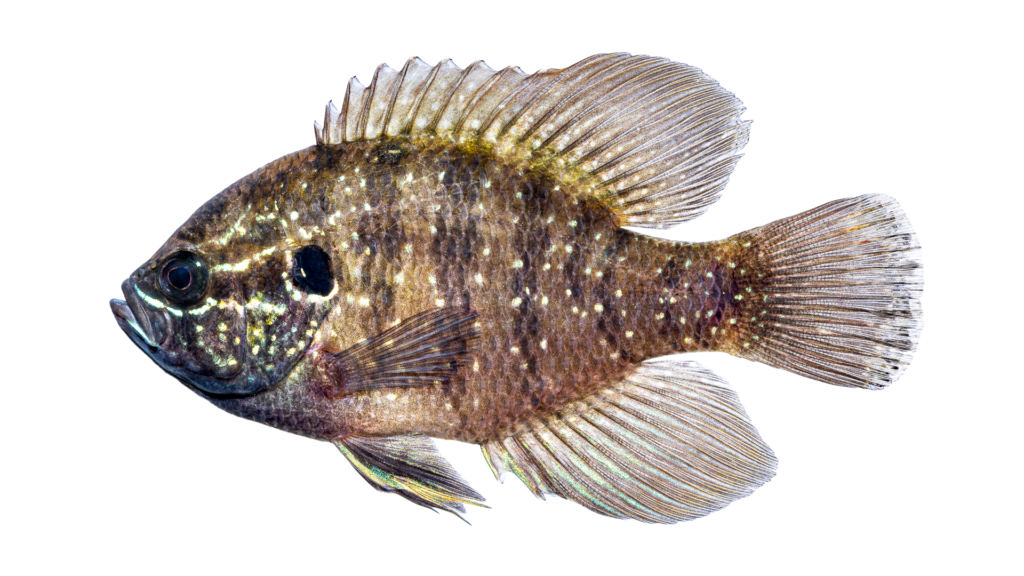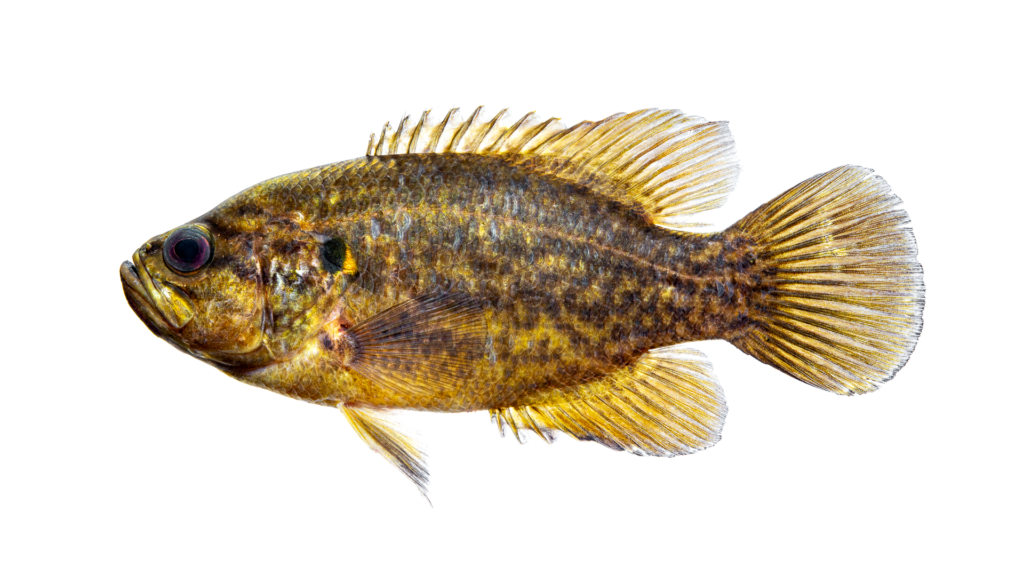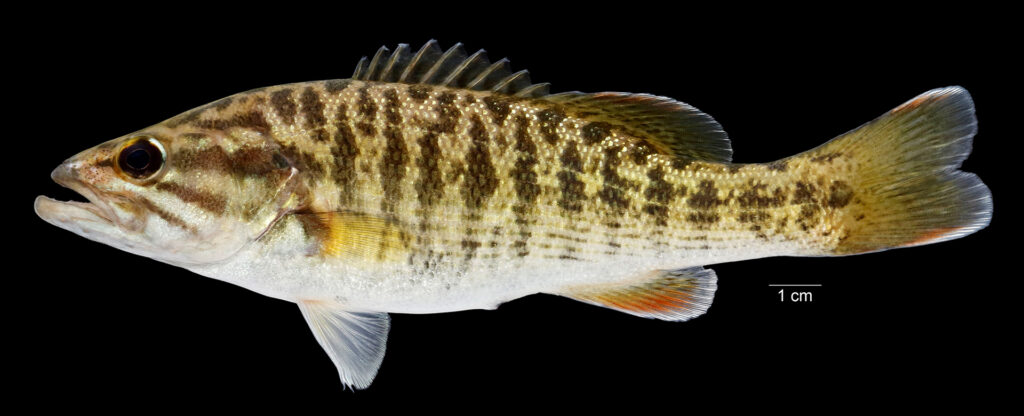By the NCFishes.com Team
There are 23 species of sunfishes in North Carolina (Table 1), including one undescribed species, “Bartram’s” Bass and one species, Redeye Bass, found in only the Hiwassee River basin (Tracy et al. 2020). You might have heard people calling them Stumpknocker, Bream, Goggleye, Robin, Perch, Shellcracker, Bronzeback, Kentucky Bass, Welshman, Tinmouth, Sac-a-lait, or many other colloquial names. But each species has its own scientific (Latin) name, which coincidentally actually means something (please refer to The Meanings of the Scientific Names of Sunfishes, pages 12-13), and an American Fisheries Society-accepted common name (Page et al. 2013).
Table 1. Species of sunfishes found in North Carolina. Common name enclosed within tickmarks (“) is a scientifically undescribed species.
| Scientific Name/ American Fisheries Society Accepted Common Name | Scientific Name/ American Fisheries Society Accepted Common Name |
|---|---|
| Acantharchus pomotis, Mud Sunfish | Lepomis marginatus, Dollar Sunfish |
| Ambloplites cavifrons, Roanoke Bass | Lepomis microlophus, Redear Sunfish |
| Ambloplites rupestris, Rock Bass | Lepomis punctatus, Spotted Sunfish |
| Centrarchus macropterus, Flier | Micropterus coosae, Redeye Bass |
| Enneacanthus chaetodon, Blackbanded Sunfish | Micropterus dolomieu, Smallmouth Bass |
| Enneacanthus gloriosus, Bluespotted Sunfish | Micropterus henshalli, Alabama Bass |
| Enneacanthus obesus, Banded Sunfish | Micropterus punctulatus, Spotted Bass |
| Lepomis auritus, Redbreast Sunfish | Micropterus salmoides, Largemouth Bass |
| Lepomis cyanellus, Green Sunfish | Micropterus sp. "Bartram's" Bass |
| Lepomis gibbosus, Pumpkinseed | Pomoxis annularis, White Crappie |
| Lepomis gulosus, Warmouth | Pomoxis nigromaculatus, Black Crappie |
| Lepomis macrochirus, Bluegill |
Sunfishes are found throughout our state from the Mountains to the Sand Hills to the Coastal Plain in reservoirs, creeks, large and small rivers, swamps, channelized streams, and permanent wetlands. They can be found in cool, gin-clear Mountain streams to warm and turbid Piedmont streams to low pH, tannin (tea)-colored Sand Hills and Coastal Plain streams. Sunfishes are generally found in deep pools or slow-moving runs, snags, or beneath undercut banks. They even blend in with their surroundings where submersed aquatic plants are plentiful. One can find some species of sunfishes thriving even in some of our most degraded urban streams. Distributional maps for every species may be found in Tracy et al. (2020).

Sunfishes range in size from the petite Enneacanthus species (Bluespotted, Banded, and Blackbanded sunfishes) who are less than four inches in length to the big-bellied “hawgs” of the Black Basses who approach 30 inches in length. Most people are familiar with sunfishes because they are recreationally important sport and gamefish. As table fare, they can also be found on ice or swimming in tanks at local seafood markets.
Each of North Carolina’s 100 counties has at least one species of sunfish found within its borders and there are three species, Redbreast Sunfish, Bluegill, and Largemouth Bass, that can be found in each of North Carolina’s 21 river basins. Historically, 19 species called North Carolina home with the Cape Fear, Lumber, Waccamaw, and Shallotte River basins having the most diverse faunas, each having 13 of the 19 indigenous (native) species.
Some of our indigenous species were restricted to very specific river basins or physiographic regions. For example. Roanoke Bass was endemic to the Tar, Neuse, and Roanoke River basins and “Bartram’s” Bass was restricted to the Savannah River basin. Four species were found only west of the Appalachian Mountains – Smallmouth Bass, Spotted Bass, Rock Bass, and White Crappie; other species were found only east of these mountains – Redbreast Sunfish, Pumpkinseed, and Warmouth. Bluegill was not found north of the White Oak River basin; it was not indigenous to the Neuse, Tar, Roanoke, Chowan, or Albemarle River basins. Even today, Mud Sunfish, Flier, Bluespotted Sunfish, Blackbanded Sunfish, Banded Sunfish, Dollar Sunfish, and Spotted Sunfish are found almost exclusively in the Coastal Plain and Sand Hills. Historically, it is believed that Largemouth Bass were found in every basin, except for the New.

Our most diverse basin today is the Yadkin where 19 species are found, but 7 are nonindigenous (introduced). Our least diverse basins are the small headwater basins of the Savannah and Watauga where just six species are found in each basin and two of them are introduced. Despite widespread introductions and stockings, the White Oak and Shallotte basins continue to have more than 90% of their original faunas intact. And because of their small size and unimportance as sportfish, seven species have never been introduced into other river basins – Mud Sunfish, Flier, Blackbanded Sunfish, Banded Sunfish, Bluespotted Sunfish, Dollar Sunfish, and Spotted Sunfish.
Unfortunately, because of their popularity as a sport fish, several species have been introduced, legally or illegally, outside their historical North Carolina ranges or have been imported into our state. In the New basin, unbelievably, no species of sunfishes were historically found; but today in the New, all nine species which are found there are introduced – Rock Bass, Redbreast Sunfish, Green Sunfish, Pumpkinseed, Bluegill, Redear Sunfish, Smallmouth Bass, Largemouth Bass, and Black Crappie. Green Sunfish, Redear Sunfish, Redeye Bass, and Alabama Bass were not indigenous to North Carolina, but are now part of our fauna. Alabama Bass is North Carolina’s most recent unauthorized introduced species and is now found in several of our Piedmont reservoirs and big rivers. One of the deleterious consequences of these widespread introductions is that several of the genera, e.g., Lepomis, Ambloplites, and Micropterus readily hybridize within their genus resulting in fish that are not “pure” species anymore. Hybrids of the Black Basses (Spotted, Largemouth, Smallmouth, and Alabama) are now common where the species co-occur. Hybrids of the endemic Roanoke Bass and introduced Rock Bass can now be found in the upper Roanoke basin and have displaced and genetically swamped the endemic Roanoke Bass.

Because all the species in the Family Centrarchidae are classified and managed as game species by the North Carolina Wildlife Resources Commission (NCWRC 2020), none are considered imperiled in North Carolina (NCAC 2017; NCWRC 2017). However, the North Carolina Natural Heritage Program has listed the Roanoke Bass, Blackbanded Sunfish, Banded Sunfish, and “Bartram’s” Bass (listed as Redye Bass) as Significantly Rare (NCNHP 2018).
Key characteristics for their proper identification include the shape of the caudal and pectoral fins; the pattern of blotches along the lateral line; counts of anal and dorsal fin spines and lateral line scales; size of mouth; and overall color patterns (please refer to Identification Key to the Species of Sunfishes (Family Centrarchidae) in North Carolina). Most species can easily be told apart from one another, with the possible exceptions of Black Bass and Ambloplites hybrids and females and juveniles of Banded vs. Bluespotted sunfishes.
If you have troubles with your identifications, just send us (https://ncfishes.com/contact/) an e-mail and include as many quality digital photographs as you can along with all the pertinent locality descriptors so that we will know from where the fish came.